Day 3 of a three day Autumn Tour today, our last day. We spent the morning in North Norfolk and the afternoon down in the Brecks. There were some nice sunny spells again, particularly in the afternoon, when it was quite warm. It almost felt like the summer we never had!
There had been a Common Crane with the Greylags at Iron Road yesterday, so we swung round via there on our way to Cley this morning. We had a quick scan through the geese as we passed, but there was no sign. It was only when we had parked at Walsey Hills and got out of the minibus that we were able to check messages and saw that it had already flown to the fields east of Salthouse.
We had a walk down the footpath through the bushes. They were ringing this morning, so there was quite a bit of disturbance around the feeders. We did manage to add Great Tit to the trip list and saw a few Greenfinches and Chaffinches flying in and out. One of the group heard a Goldcrest singing and it was only when we walked on a little further and heard Iberian Chiffchaff song that we realised something was wrong! The ringers were using a recording of various songs on a loop to try to lure in unsuspecting birds to the nets. There were on or two real Chiffchaffs in there and we saw one flitting about in the bushes at the far end.
There was no sign of any migrants fresh in, so we walked back to the minibus and made the short drive down past Salthouse towards Kelling. There were some Canada Geese a couple of fields over in the stubble and we eventually found somewhere to get the minibus off the road. A quick scan from the verge confirmed the Common Crane was with them, so we walked up the edge of the stubble to find a safe spot we could view from.
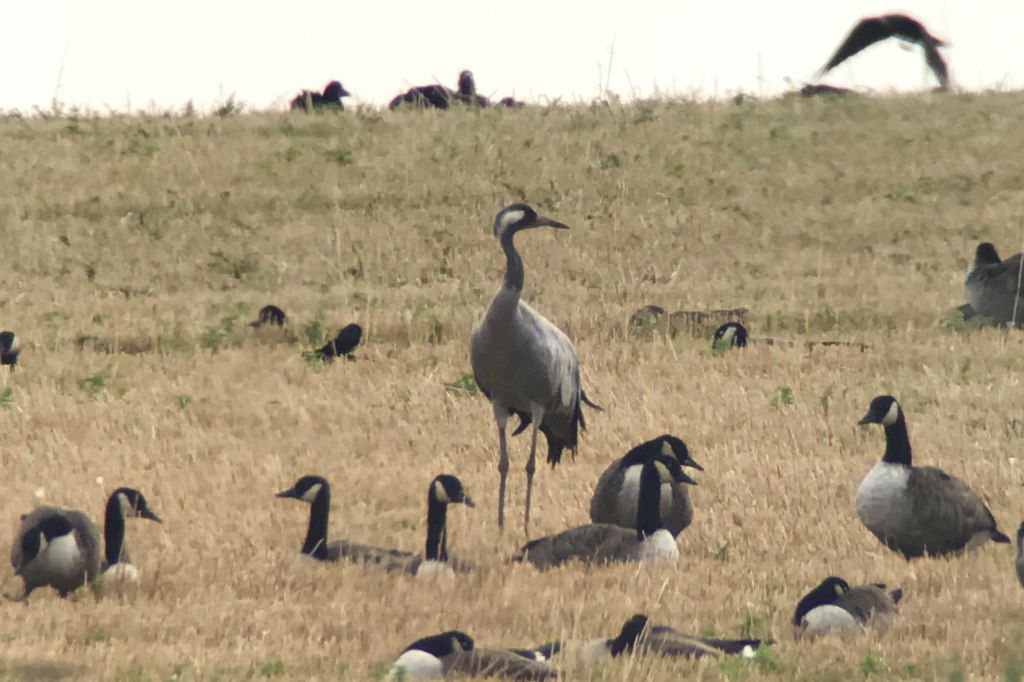
The Crane looked rather incongruous surrounded by Canada Geese! Presumably this is the same lone bird which has been drifting up and down the coast all year. Always a good way to start the day, with a Crane. There were a few Curlews and Black-tailed Godwits distantly out on the grazing marshes and a female Marsh Harrier drifted down the back of the stubble field and turned over the edge of Meadow Lane before heading off towards the Quags.
Back to Walsey Hills, we could resume the morning’s planned agenda. The young Little Grebes were calling on Snipe’s Marsh, but tucked in behind the reeds out of view. Up on the East Bank, an adult Little Grebe then surfaced in front of us in the middle of the blanket weed on Don’s Pool.
Scanning Pope’s Pool, we could see some distant Ruff. Several Common Snipe came up from the the edge of the Serpentine and landed again in the grass. A group of Black-tailed Godwits was busy feeding in the water. One or two of the Rooks seemed to be delighting in chasing waders – chasing after first a Ruff and then a Curlew. There looked to be some more interesting waders further up, so we walked on to the north end of the Serpentine.
The highlight here was a very crisp, fresh juvenile Wood Sandpiper which looked very smart through the scopes. There were a couple of Dunlin as well, plus more Ruff and Black-tailed Godwits, a lone Avocet and two more Common Snipe on the edge of the emergent reeds on the far side. There had been a Curlew Sandpiper here last night and first thing this morning, but we couldn’t see it now. We checked with some people we had seen out on the bank earlier and were told it had been flushed by a Sparrowhawk and flown off, so we moved on.
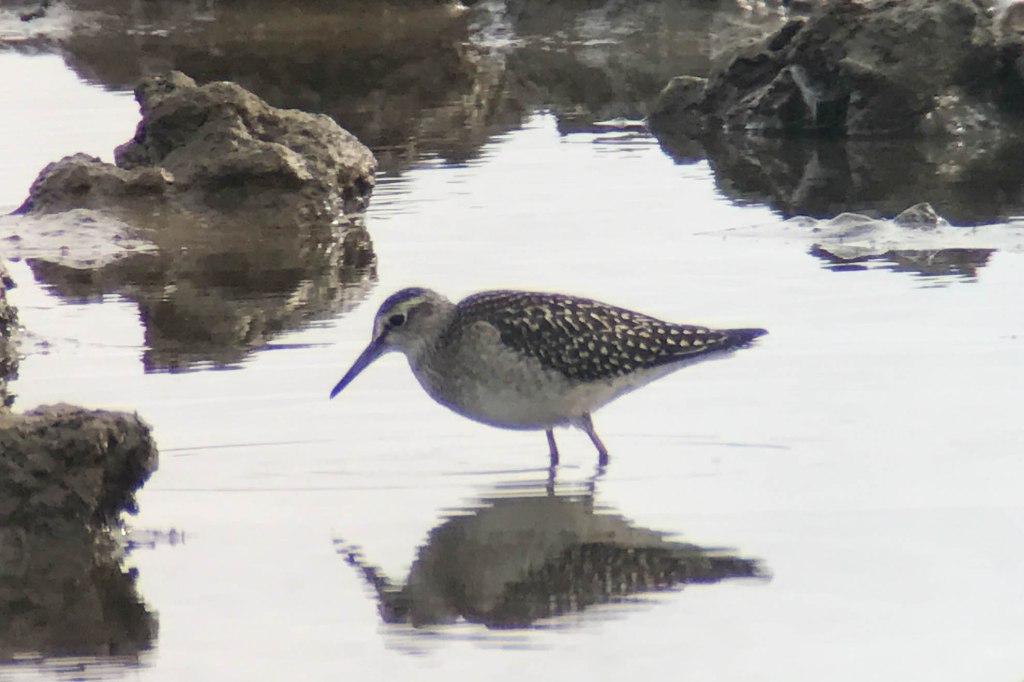
There were a few Meadow Pipits in the short grass in the corner and when we stopped to scan we noticed movement on the edge of the reeds just behind. Two Reed Buntings and three different Reed Warblers appeared in the reeds as we watched.
One of the group spotted a Hobby high over the reeds behind us. It was gliding away from us at first, but then turned and started to fly higher still with rapid wingbeats. It caught something, possibly a dragonfly, and proceeded to eat it on the wing, bringing its feet up to its bill.
A small flock of Sandwich Terns on Arnold’s Marsh kept flying round and calling as we walked up. We scanned from the bank in the sunshine. A lone Greenshank was feeding in with the Redshank at the back. A juvenile Bar-tailed Godwit flew up and looked to be heading off west before it looped back round and landed again in with the Black-tailed Godwits. It was joined by a second Bar-tailed Godwit a little later. A single Knot was picking around on one of the shingle bars and two more Avocets were asleep nearby. Two Pintail were upending right in the far corner.
Out on the Brackish Pools, there were a couple of Turnstones along with a few more Black-tailed Godwits, Redshank and Curlew. A Water Rail squealed from somewhere in the reeds down the main drain and we could hear a Cetti’s Warbler calling along there too. Two more Knot flew in from the west and dropped down towards Arnold’s.
As we walked up to the beach, a small bird flew from one of the big lumps of concrete on the shingle. A flash of white rump as it landed on the start of the low ridge to our right confirmed it was a Wheatear. We had a nice view of it as it fed on the vegetated slope of the bank.
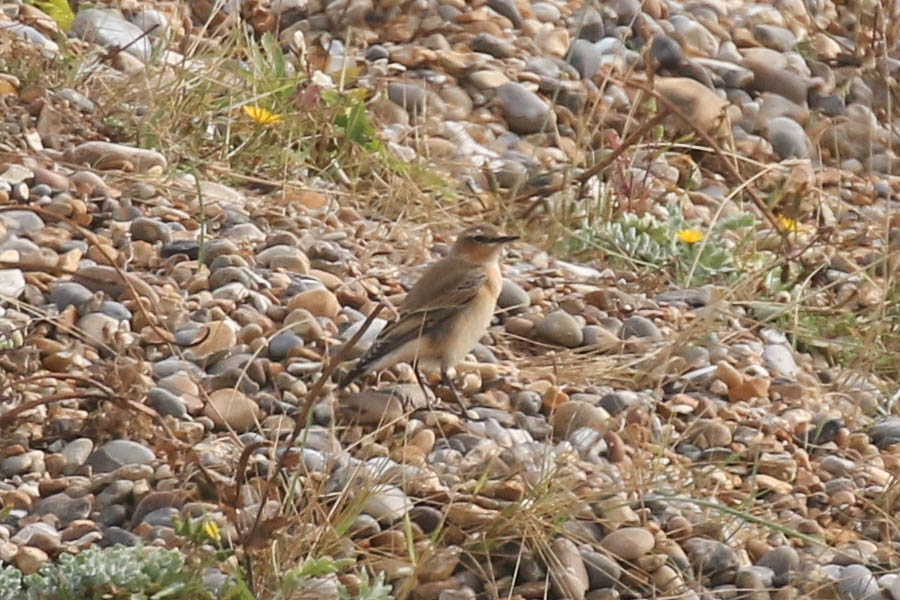
Scanning the sea, we picked up a couple of juvenile Gannets just offshore, one of which continued past us, and then we noticed an adult flying past a bit further out. A Guillemot was on the sea and then we noticed a Red-throated Diver just off the beach, diving in the breakers a short distance to the east. It was coming out way and we had a great view of it, an adult just moulting out of breeding plumage, we could still see its red throat as it turned and caught the sun.
The Red-throated Diver eventually seemed to see the crowd gathered on the shingle and worked its way a bit further out, drifting with the tide and preening for a while. It came back in towards the beach back to the east but was then disturbed by a dog diving in and out of the waves and drifted off rapidly towards Salthouse.
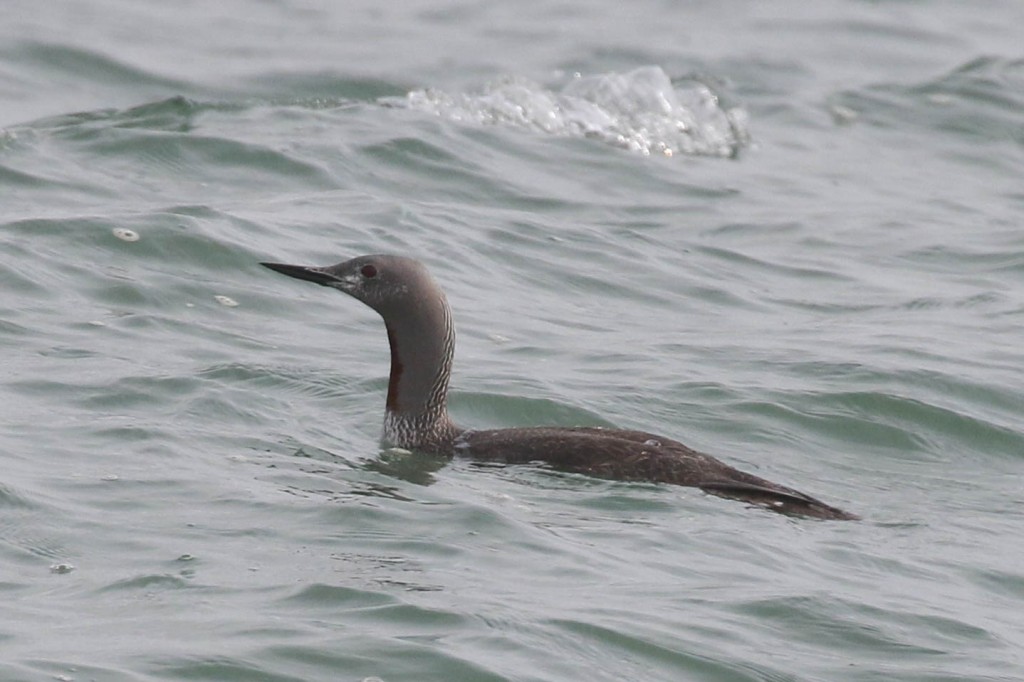
It was all action on the beach for a while, but then it went quiet. We couldn’t see anything moving offshore now, so we decided to head back. There was still no sign of the Curlew Sandpiper back on the Serpentine. A large flock of at least 40 Meadow Pipits flew in high over the reedbed and dropped in on the grazing marsh. There has been a big movement of Meadow Pipits down along the Yorkshire coast the last couple of days, so these were probably migrants arriving here. We could see a couple of juvenile Little Grebes on Snipe’s Marsh now.
It was almost midday when we arrived at the Visitor Centre car park. We had thought about having a quick look out from the hides, but there was nothing we hadn’t seen already on the information board and we didn’t have a lot of time now, if we wanted to head inland this afternoon. We had a quick scan of Pat’s Pool from the terrace, but we couldn’t see anything to tempt us to change our plans, so we opted for an early lunch in the sunshine. A smart male Ruddy Darter was basking on one of the picnic tables.
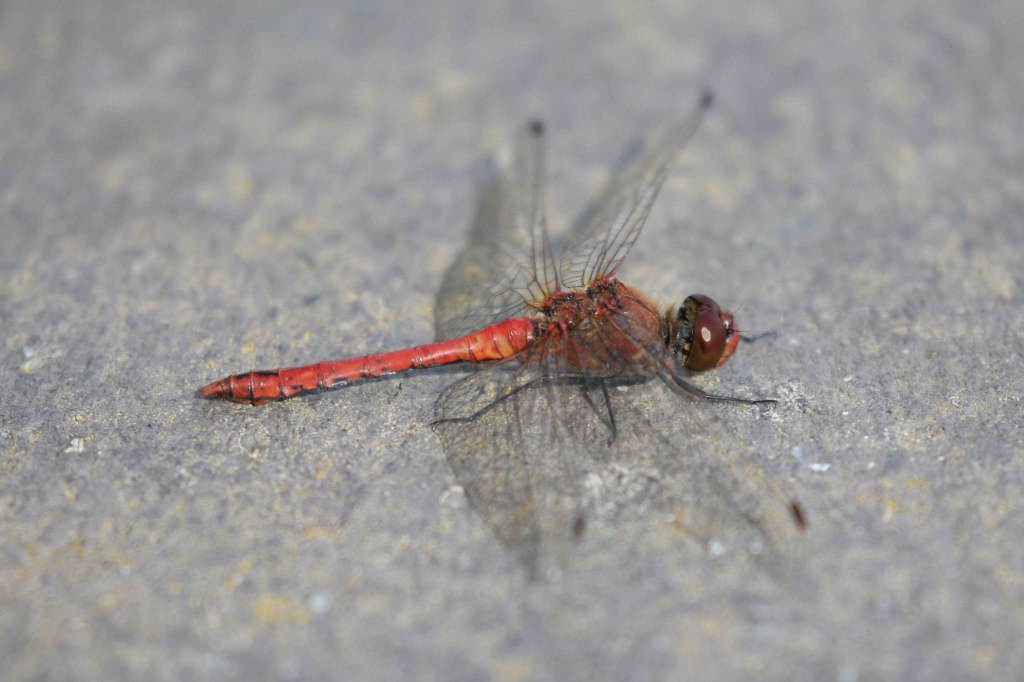
After lunch we headed off on the long drive down to the Brecks. We were hoping to find some Stone Curlew, as now is the time to see them in their big post-breeding gatherings. We found somewhere to park off the road and got out to scan the field opposite. We could immediately see about ten, but they were rather distant and there was still lots of heat haze. It was forecast to cloud over this afternoon but was still stubbornly sunny, and the combination of sunshine and bare flinty Breckland soil always means lots of shimmer. Still, Stone Curlew was a new bird for several of the group so it was nice to see them, particularly when one stood up that was a bit closer to us.
Stone Curlew feed at night and are active at dawn and dusk, spending most of the day roosting. So they can be hard to see here, well camouflaged against the soil when sat down, or hiding in patches of vegetation. As we stood and watched, we realised there were more here than we had first seen, with others appearing as they stood up or moved. Eventually we figured there were around twenty here.
There were a few other birds here – a flock of 53 Golden Plover flew over calling a couple of times. We had a brief view of a chat on an old farm building further down – it looked pale below, like it could be a Whinchat, but it was very distant in the haze and dropped down before we could get a good look at it. We decided to walk down the road to see if we could get another look at it from further along.
As we walked down the road, we had a quick scan of the field the other side. Another Stone Curlew was standing up out in the middle and was quite obvious, so we got the scope on that – the views were slightly better than the others we had seen, if still rather distant. Scanning across we figured there were at least another eight Stone Curlews in here, mostly sat down in the clods of ploughed earth, and probably a lot more we couldn’t see further back.
We stopped in a gateway further down which was directly opposite the old farm buildings, but there was no sign of the chat here now. A few Pied Wagtails were feeding around the edges and a flock of Linnets dropped in. There were lots of Lesser Black-backed Gulls out on the stony ground in the middle too.
There were even more Stone Curlews out in the field here, but they were mostly hidden in the vegetation. At first, all we could see was the odd brown head in amongst the brown dried plants. We got the scope on one and had a good view of a bright yellow iris staring back at us. Again, as we stood and watched birds started to move. At one point, several stood up and started to preen – perhaps mid-afternoon they were starting to get a little restless after a long day in hiding. There were more here that we had realised and some were much closer – now we had some really good views through the scopes.
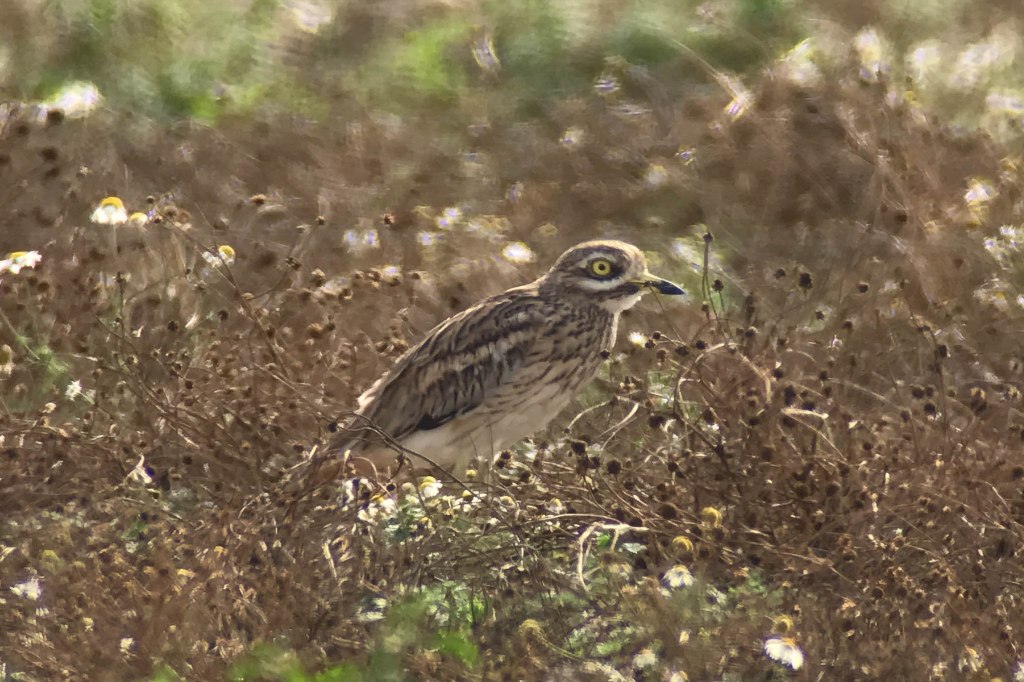
Everyone agreed it had been well worth the drive down to see the Stone Curlews. We totted up and figured we had probably seen around 65 in total, an impressive number, and had some really good views. Always a great way to finish the tour at this time of year, it was now time to head back.
















